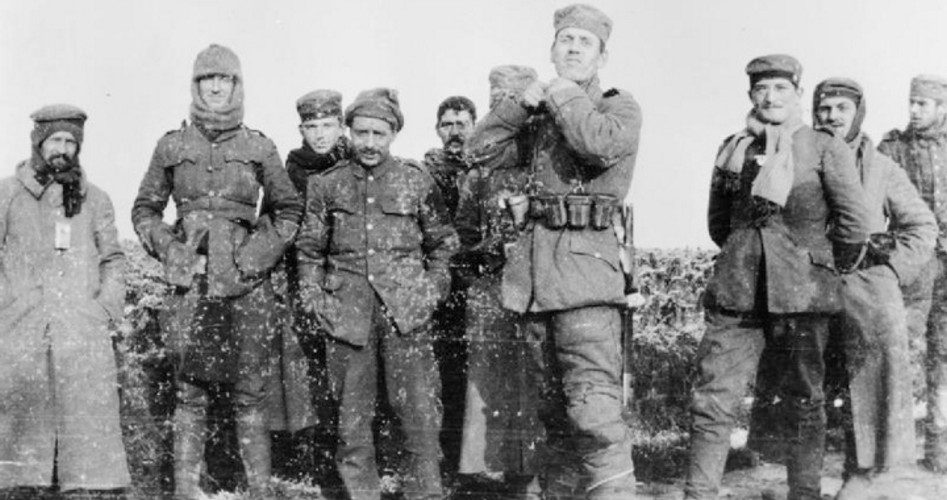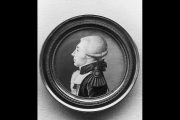
What if they called a war and peace broke out instead? That’s exactly what happened during the Christmas season of 1914 when the soldiers themselves called a truce and, had it not been for intervention by the higher authorities on both sides, World War I might have ended.
Stanley Weintraub does an excellent job of preserving for posterity this remarkable wartime truce in his book Silent Night: The Story of the World War I Christmas Truce, and much of what follows is derived from that valuable source. The truce came as no surprise, Weintraub explains, as there were early indications that some of the fighting men might lay down their arms for a Christmas truce, particularly between the British and German lines near Ploegstreert Wood in Belgium. Many of these troops held no animosities toward each other and questioned their reasons for being involved in the war. The opposing trenches were close enough for them to see and hear each other preparing to celebrate the same Christian holiday, Christmas.
Intelligence reports indicating friendly exchanges and the possibility of an informal truce prompted British Brigadier General G. T. Forrestier-Walker to issue an order forbidding the friendly exchanges. When Forrestier-Walker’s directive didn’t stop the friendly exchanges, the high command reacted by trying to step up the war, ordering attacks on German trenches. In general, these costly attacks failed not only militarily but also in terms of stopping the truce. The final attempt to prevent the truce came on Christmas Eve when the British high command issued a bogus intelligence report of a supposed impending German attack. Very few commanders believed this phony intelligence report, relying instead on their own intelligence information, which was that the German troops were in all-out preparation alright — to celebrate Christmas.
During Christmas Eve, soldiers on both sides could hear numerous Christmas carols being sung in the trenches on the other side. One particularly solemn moment occurred in the trenches near Ploegstreert Wood. At 11:00 p.m., which was at midnight in Berlin, Germany, there was a booming baritone voice singing the beloved Christmas carol “Stille Nacht” (“Silent Night”). History has failed to record the name of this man who sang “Stille Nacht,” but his singing of this beloved Christmas carol had an enormous psychological effect on the soldiers of both sides. Despite official pronouncements to the contrary, the soldiers in those trenches slept that night knowing in their hearts that a Christmas truce had begun. There were many Christmas carols, the singing of each hymn communicating peace amongst those who sang them and those who heard from opposing trenches, but “Silent Night” seems to be the one stood out the most.
Soldiers sang Christmas carols again on Christmas morning. Soon sign boards began popping up from the trenches. Because there were more German soldiers who spoke English than English soldiers who spoke German, the predominant language used on the sign boards was English, sometimes broken English, such as, “You no fight, we no fight.” Soon, soldiers emerged from the trenches advancing toward the opposing trenches armed not with weapons, but with gifts: Tobacco products, chocolates, cakes, even sausages. The men met, exchanged gifts, and arranged for decent Christian burials of the dead who had fallen in what was no-man’s-land only a few days earlier. The informal truce even included soccer games and beer drinking. Sadly, the news of the truce spread with unequal speed along the trenches on both sides and, consequently, there were a few casualties in some locations.
In one sector, the German soldiers communicated their desire for a truce verbally, including an offer to share their beer. They then rolled a barrel of beer into the middle of no-man’s land between them, and that’s how the truce began in that sector.
There were numerous acts of bravery by these men who were waging peace instead of war. One such hero was Alfred Kornitzke, a pastry cook from Berlin, Germany, who was making marzipan balls in a German trench on Christmas Eve when enemy fire endangered him. He picked up a Christmas tree and, while still wearing his baker’s hat, ran toward the enemy lines, which were manned by Algerians. When he got about half way across the no-man’s land, he put the Christmas tree down and lit the candles. The astounded Algerians ceased fire. Kornitzke vowed that after the war he would become a missionary to the heathens saying, “For now I know how it’s done.”
There were reports of participants in the truce as high as the rank of colonel. Of course, there were some who refused to participate in the truce. Among those was a German field messenger, Corporal Adolf Hitler. Corporal Hitler, an atheist, also refused to participate in the religious observances of Christmas that were held.
As a retired military officer, I can tell you that one of the greatest fears a military officer has is that a direct order will be disobeyed en masse. The high commands of all participating countries in the war reacted decisively to restart the hostilities. There were visits directly to the trenches by high-ranking officers, even generals. From the German side came a report that the men were redressed by an officer who ordered the men in the foulest of language to start shooting, saying, “Fire, or we do — and not at the enemy!” The men in this case reportedly spent that day and the next firing their rifles, but deliberately firing above the opposing troops “wasting ammunition in trying to shoot the stars down from the sky.”
One technique used by military officers to break up groups of troublemakers is to transfer them to different units. In this case, the same tactic was used to break up the groups of soldiers who participated in the Christmas truce. Numerous units were transferred. Soldiers on both sides who refused to fire their weapons at each other soon found themselves transferred to different locations along the front and facing enemy soldiers who had not participated in the Christmas truce, who were firing at them.
Additionally, the military leaders tried to keep the news of the truce from spreading. Despite these efforts at truth suppression, word of the truce did leak out, primarily via letters that soldiers wrote back home and from letters that were exchanged during the truce for soldiers who wanted to send letters to relatives on the other side. Some of these letters found their way into the hands of newspaper editors, though not in time to maintain the truce and allow for analytical minds to assess the necessity of the war.
An event such as this does raise the question of freedom of the press in a war zone. The U.S. Constitution does not have a disclaimer exempting war zones from freedom of the press, yet it is almost universally believed that our news media should be in some form of obedience to our military when reporting news from war zones. After all, who would want to see a reporter disclose news of military value to an enemy? But the acts of truth suppression by military high commands and other high-level government leaders regarding the news of the Christmas Truce of 1914 cannot be defended in any terms of protecting military intelligence information from an enemy. This was a case of information control over military information for political purposes to keep the people from learning that a significant portion of a war had come to halt on its own.
Eventually the high commands of the warring nations prevailed, and the hostilities resumed. The casualties once again mounted in the bloody war. Steps were taken to preclude further Christmas truces. Subsequent Christmases saw artillery barrages, trench raids, and mortar attacks. Despite the deliberate increases in hostilities during those Christmas seasons, there were some localized truces, but they were few in number and small in scope.
In 1999, the Christmas Truce of 1914 was commemorated by a small group of re-enactors who, after spending a few nights in makeshift trenches in the area near Ploegstreert Wood, left behind a wooden cross. That wooden cross has since been fortified with a cement base by some of the local people and now stands as the only monument to the Christmas truce of 1914. This is a sad commentary on how governments build many monuments supposedly to honor military veterans, but somehow seem to do so in ways that glorify war. Perhaps there will be a 100th anniversary reenactment in 2014. I would like to suggest that a fitting monument would be that of three soldiers in German, British, and French uniforms of that era bearing gifts of tobacco, chocolate, and sausages — a modern reference to the wise men who visited the Christ child bearing gifts of gold, frankincense, and myrrh.
Wars, unlike chess where there is no pretense that the battle being waged is for the benefit of the board or the chess pieces, are typically portrayed as if they are for the benefit of a nation including her soldiers, although only a few actually are. At least in this case, the pawns in the game used their God-given wisdom to realize there was something really wrong and almost ended the war on their own.
The spark that ignited World War I — the assassination of Archduke Franz Ferdinand, heir to the throne of Austria-Hungary, by a Bosnian Serb — did not involve the national interests of other European countries. Yet when Austria attacked Serbia, holding Serbia responsible for the action of Ferdinand’s assassin, leaders of other European powers plunged their nations into the war. Eventually the United States joined the conflict as well.
In Silent Night: The Story of the World War I Christmas Truce, Weintraub delves a bit into alternative history and discusses subsequent historical events, such as the formation of the League of Nations, and how they might not have happened had World War I either never occurred or ended more quickly.
The formation of the League of Nations (like the formation of the United Nations a generation later) was intended by its architects to provide the organizational framework for a future world government. But this early drive for world government was derailed when the U.S. Senate rejected U.S. membership in the League. John Birch Society founder Robert Welch repeatedly stated that World War I was not the genesis behind this drive for world government but that the war was actually a means employed by the internationalist-minded power elites to try to bring about their desired new world order.
The Christmas Truce of 1914 is certainly in harmony with Welch’s view. After all, why else would the leaders of the warring countries wait until after the Armistice in 1918 to form a League of Nations, supposedly for the purpose of ending wars, when World War I almost ended itself in 1914 and it was only after their deliberate efforts to restart the hostilities that the war continued? The Christmas Truce of 1914 indicates a total lack of legitimacy of World War I and, along with that, it shows the lack of necessity for the League of Nations and the United Nations.
The photo at the top shows British and German soldiers meeting in No Man’s Land during the 1914 Christmas Truce.
This article was originally published online on December 21, 2008.



